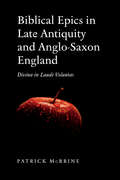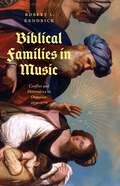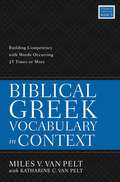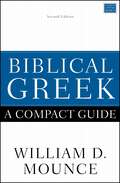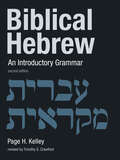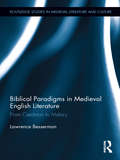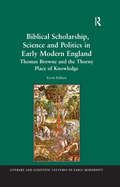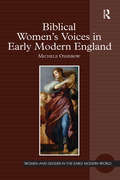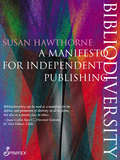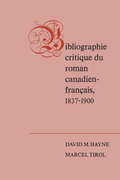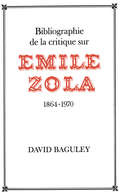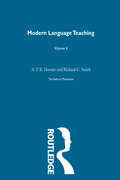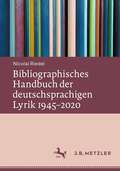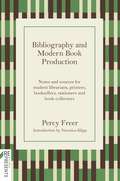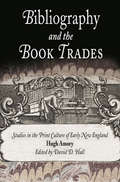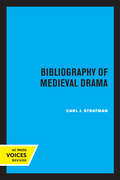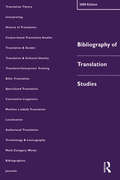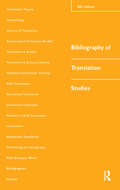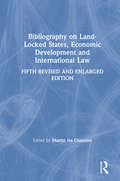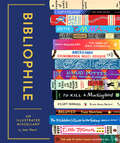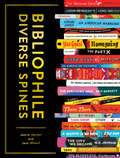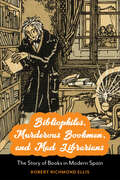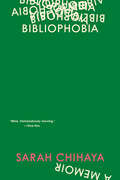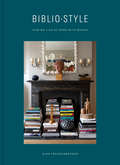- Table View
- List View
Biblical Epics in Late Antiquity and Anglo-Saxon England: Divina in Laude Voluntas
by Patrick McbrineBiblical poetry, written between the fourth and eleventh centuries, is an eclectic body of literature that disseminated popular knowledge of the Bible across Europe. Composed mainly in Latin and subsequently in Old English, biblical versification has much to tell us about the interpretations, genre preferences, reading habits, and pedagogical aims of medieval Christian readers. Biblical Epics in Late Antiquity and Anglo-Saxon England provides an accessible introduction to biblical epic poetry. Patrick McBrine’s erudite analysis of the writings of Juvencus, Cyprianus, Arator, Bede, Alcuin, and more reveals the development of a hybridized genre of writing that informed and delighted its Christian audiences to such an extent it was copied and promoted for the better part of a millennium. The volume contains many first-time readings and discussions of poems and passages which have long lain dormant and offers new evidence for the reception of the Bible in late Antiquity and the Middle Ages.
Biblical Families in Music: Conflict and Heterodoxy in Oratorios, 1670–1770
by Robert L. KendrickExamines how stories of biblical families were reconfigured and projected in the genre of the oratorio, a form of sacred opera, in the seventeenth and eighteenth centuries. Based to a great extent on the Old Testament, the largely Catholic musical-dramatic genre was popular in Italy, Austria, and southern Germany in the seventeenth and eighteenth centuries. Biblical Families in Music reveals how difficult stories of fratricide, child sacrifice, death, and forbidden love performed a didactic function in oratorios, teaching early modern audiences about piety and the rules of proper family life. In the century after 1670, the heavily adapted tales of Abraham and Isaac, Cain and Abel, and the Egyptian slave Hagar and her son Ishmael were set to music by figures such as Alessandro Scarlatti and Antonio Sacchini and performed during Lent in churches and other sacred spaces for an audience of court nobility, clergy, and the urban patriciate. By examining the resonance of Catholic oratorios within predominantly upper-class social realities, the book broadens our cultural understanding of the early modern European family and underscores the centrality of family and familial relation to social position, devotional taste, and identity.
Biblical Greek Vocabulary in Context: Building Competency with Words Occurring 25 Times or More
by Miles V. Van PeltBiblical Greek Vocabulary in Context by Miles V. Van Pelt is designed to reinforce a student's basic Greek vocabulary by presenting words that occur twenty-five times or more in the context of the Greek New Testament.Miles Van Pelt collates all 513 of these Greek words into approximately 200 key biblical verses and/or verse fragments to help students practice reading them in their literary context and thus improve their Greek vocabulary retention. Rather than rote memorization, Van Pelt's approach teaches word meaning through each word's naturally occurring context--the way people naturally learn languages.The book includes two primary sections:The first section provides room for students to write their own glosses of the biblical verse and to parse as they feel necessary. An English translation is also provided, and any term that appears less than twenty-five times is glossed. Proper names are identified with gray text.The second section of the book provides the same biblical verses from the first section but with minimal room to write glosses and parse and without an English translation for aid. The end of the book includes a Greek-English lexicon of all the words occurring twenty-five times or more in the Greek New Testament.
Biblical Greek: Second Edition
by William D. MounceBiblical Greek: A Compact Guide, Second Edition by William D. Mounce is a handy, at-a-glance reference for students, pastors, and teachers. It follows the organization and format of the fourth edition of Basics of Biblical Greek Grammar, but it is also usable by students who learned with a different grammar. By limiting its discussion to the "nuts and bolts," Greek language students working on translation and exegesis will more quickly and easily find the relevant grammatical refreshers. Students can, for example, check on the range of meaning for a particular word or make sure they remember how aorist participles function in a sentence. The paradigms, word lists, and basic discussions in Biblical Greek: A Compact Guide Second Edition points students in the right direction and allow them to focus on more advanced Greek study.
Biblical Hebrew: An Introductory Grammar
by Page H. KelleyA standard, much-used textbook updated and improved Comprehensive in scope, this carefully crafted introductory grammar of Biblical Hebrew offers easy-to-understand explanations, numerous biblical illustrations, and a wide range of imaginative, biblically based exercises. The book consists of thirty-one lessons, each presenting grammatical concepts with examples and numerous exercises judiciously selected from the biblical text. These lessons are accompanied by eleven complete verb charts, an extensive vocabulary list, a glossary of grammatical terms, and a subject index. In this second edition Timothy Crawford has updated the text throughout while preserving the Page Kelley approach that has made Biblical Hebrew so popular over the years.
Biblical Narrative and the Formation of Rabbinic Law
by Jane L. Kanarek"This book presents a new framework for understanding the relationship between biblical narrative and rabbinic law. Drawing on legal theory and models of rabbinic exegesis, Jane L. Kanarek argues for the centrality of biblical narrative in the formation of rabbinic law. Through close readings of selected Talmudic and midrashic texts, Kanarek demonstrates that rabbinic legal readings of narrative scripture are best understood through the framework of a referential exegetical web. She shows that law should be viewed as both prescriptive of normative behavior and as a meaning-making enterprise. By explicating the hermeneutical processes through which biblical narratives become resources for legal norms, this book transforms our understanding of the relationship of law and narrative as well as the ways in which scripture becomes a rabbinic document that conveys legal authority and meaning"--
Biblical Paradigms in Medieval English Literature: From Cædmon to Malory
by Lawrence BessermanThis book examines the intricate and unusual relationship between the sacred and secular spheres of English medieval culture, positing that the assimilation of sacred and secular motifs could be in either direction, or even in both directions. That is, medieval English writers could appropriate biblical paradigms to express secular themes, and vice versa. Codicological, psychoanalytic, feminist, and new historicist insights inform readings of Beowulf, Middle English lyric poetry, the Gawain-poet, Chaucer, and Malory, among others. Besserman elucidates the structural and thematic complexity of the integration of biblical and biblically derived sacred diction, imagery, character types, and themes in the works under consideration, identifying within them new biblical sources and analogues and providing fresh insights into the contextual meaning and significance of the biblical paradigms they deploy. This book highlights the shaping influence of biblical and biblically derived sacred paradigms on exemplary literature produced in the middle Ages.
Biblical Scholarship, Science and Politics in Early Modern England: Thomas Browne and the Thorny Place of Knowledge (Literary and Scientific Cultures of Early Modernity)
by Kevin KilleenKevin Killeen addresses one of the most enigmatic of seventeenth century writers, Thomas Browne (1605-1682), whose voracious intellectual pursuits provide an unparalleled insight into how early modern scholarly culture understood the relations between its disciplines. Browne's work encompasses biblical commentary, historiography, natural history, classical philology, artistic propriety and an encyclopaedic coverage of natural philosophy. This book traces the intellectual climate in which such disparate interests could cohere, locating Browne within the cultural and political matrices of his time. While Browne is most frequently remembered for the magnificence of his prose and his temperamental poise, qualities that knit well with the picture of a detached, apolitical figure, this work argues that Browne's significance emerges most fully in the context of contemporary battles over interpretative authority, within the intricately linked fields of biblical exegesis, scientific thought, and politics. Killeen's work centres on a reassessment of the scope and importance of Browne's most elaborate text, Pseudodoxia Epidemica, his vast encyclopaedia of error with its mazy series of investigations and through this explores the multivalent nature of early-modern enquiry.
Biblical Women's Voices in Early Modern England (Women and Gender in the Early Modern World)
by Michele OsherowBiblical Women's Voices in Early Modern England documents the extent to which portrayals of women writers, rulers, and leaders in the Hebrew Bible scripted the lives of women in early modern England. Attending to a broad range of writing by Protestant men and women, including John Donne, Mary Sidney, John Milton, Rachel Speght, and Aemilia Lanyer, the author investigates how the cultural requirement for feminine silence informs early modern readings of biblical women's stories, and furthermore, how these biblical characters were used to counteract cultural constraints on women's speech. Bringing to bear a commanding knowledge of Hebrew Scripture, Michele Osherow presents a series of case studies on biblical heroines, juxtaposing Old Testament stories with early modern writers and texts. The case studies include an investigation of references to Miriam in Lady Mary Sidney's psalm translations; an unpacking of comparisons between Deborah and Elizabeth I; and, importantly, a consideration of the feminization of King David through analysis of his appropriation as a model for early modern women in writings by both male and female authors. In deciphering the abundance of biblical characters, citations, and allusions in early modern texts, Osherow simultaneously demonstrates how biblical stories of powerful women challenged the Renaissance notion that women should be silent, and explores the complexities and contradictions surrounding early modern women, their speech, and their power.
Bibliodiversity: A Manifesto for Independent Publishing (Spinifex Shorts)
by Susan HawthorneIn a globalised world, megacorp publishing is all about numbers, about sameness, about following a formula based on the latest megasuccess. Each book is expected to pay for itself and all the externalities of publishing such as offices and CEO salaries. It means that books which take off slowly but have long lives, the books that change social norms, are less likely to be published. Independent publishers are seeking another way. A way of engagement with society and methods that reflect something important about the locale or the niche they inhabit. Independent and small publishers are like rare plants that pop up among the larger growth but add something different, perhaps they feed the soil, bring colour or scent into the world.Bibliodiversity is a term invented by Chilean publishers in the 1990s as a way of envisioning a different kind of publishing. In this manifesto, Susan Hawthorne provides a scathing critique of the global publishing industry set against a visionary proposal for organic publishing. She looks at free speech and fair speech, at the environmental costs of mainstream publishing and at the promises and challenges of the move to digital.
Bibliographie critique du roman canadien-francaise, 1837-1900
by David Hayne Marcel TirolCette bibliographie constitue la liste la plus complete jusqu'a ce jour des romans canadiens-francais publies avant 1900. Les compilateurs presentent une description exacte et detaillee de chaque edition publiee en volume separe, avec indication des bibliotheques ou un exemplaire de l'edition est conserve. La description est suivie d'une liste des etudes et articles qui ont ete consacres au roman en question, et dans la plupart des cas, de note bibliographiques ou biographiques. Un index des noms d'auteurs et des titres facilite la consultation des 1100 références que contient le volume. A l'heure actuelle les etudes de litterature canadienne-française sont en pleine expansion non seulement dans les universites canadiennes mais aussi dans de nombreux centres aux Etats-Unis. Par consequent cet ouvrage de reference, fruit de longues annees des recherches consacrees a l'histoire du roman canadien-francais, rendra de grands services aux professeurs et aux etudiants, aux bibliothecaires et bibliographes, aux libraires et aux amateurs du livre canadien.
Bibliographie de la Critique sur Émile Zola, 1864-1970
by David BaguleyZola scholars and those whose work in other fields--literary, historical, sociological, or artistic--brings them into contact with Zola and his works have long felt the need for a survey for the large corpus of writings on this important, widely read author. This bibliography provides just such a survey, admirably complete and intelligently organized. Aided in his research by several collaborators and by a number of libraries throughout the world, David Baguley has compiled some 8000 items covering the period from the first reviews of Zola's early works to 1970. Although his work does not pretend to be exhaustive, it contains extensive coverage of studies in English, German, Polish, and Spanish, as well as French, as essential items in many other languages. The entries are arranged chronologically by years and, within each year, alphabetically by author. An introduction outlines aims, principles, and uses. Researchers will also find helpful the list of unpublished theses on Zola from various countries, the index of authors' names and names appearing in titles and notes, and the index of themes. The latter uses the number assigned to each of the entries to facilitate speedy location of materials on particular topics--e.g. Germinal studies, Zola and the theatre, the Dreyfus case, and so on. Wherever appropriate, annotation has been provided that indicates the language, content, importance, and viewpoint of the items. This bibliography will be an indispensable reference guide for Zola scholarship.
Bibliographies and Overviews: The Reform Movement (Logos Studies in Language and Linguistics)
by Richard C. Smith A. P. R. HowattThis volume forms part of a five volume set charting the progress of the nineteenth century movement, which was instrumental in establishing international guidelines for the teaching of modern languages. It was during this period that for the first time, co-operation between phoneticians and teachers culminated in the publication of works that were instrumental in establishing the 'applied linguistic' approach to language teaching in the twentieth century. For the first time, too, the new science of psychology influenced a scientific theory of second language acquisition. The Reform Movement attracted support across Europe, spurring the development of new professional associations and journals. In turn, the publication in these journals of reports of innovative practice contributed to a greater sense of autonomy and professionalism among modern language teachers, who had hitherto tended to live under the shadow of classical language teaching. The practical innovations and theoretical suggestions for the foreign language teaching, although rooted in the nineteenth century, still have relevance today.
Bibliographisches Handbuch der deutschsprachigen Lyrik 1945–2020
by Nicolai RiedelDieses bibliographische Handbuch verzeichnet alle selbständigen als Buch erschienenen deutschsprachigen Lyrik-Veröffentlichungen von 1945 bis 2020 in einfacher Titelaufnahme. In einem ersten Teil werden Jahresverzeichnisse 1945 bis 2020 mit jeweils alphabetischer Autorenreihenfolge präsentiert. In einem zweiten Teil ist der Titelbestand alphabetisch nach Verfasser/in sortiert. Grundlage ist ein Bestand von mehr als 12.000 Titelaufnahmen. Die Auswahl berücksichtigt keine Anthologien verschiedener Verfasser, keine gattungsmäßig gemischten Werke, keine Zeitschriften und keine Online-Publikationen. Mit dieser größten Bibliographie zur Lyrik nach 1945 sind erstmals umfassende Recherchen zu weitergehenden Analysen der Geschichte der Lyrik der Gegenwart möglich.
Bibliography and Modern Book Production: Notes and sources for student librarians, printers, booksellers, stationers, book-collectors
by Percy FreerBibliography and Modern Book Production is a fascinating historic journey through the fields of print history, librarianship and publishing. It covers key developments from 1494 to 1949 in bibliography and book production from the history of scripts and paper manufacture to the origins of typefaces and printing. Although not a textbook, the book was a guide for library students in the 1950s on the essential literature of librarianship.As the first librarian appointed to Wits University in 1929, Percy Freer’s near encyclopaedic knowledge of the subject of bibliography enabled him to develop a key resource for relevant library examinations in South Africa and abroad. Due to its immense value as a historic record, and to acknowledge Freer’s contributions as scholar, librarian and publisher, it is being reissued as part of the Wits University Press Re/Presents series to make it accessible to scholars in book histories, publishing studies and information science.
Bibliography and the Book Trades
by David D. Hall Hugh AmoryHugh Amory (1930-2001) was at once the most rigorous and the most methodologically sophisticated historian of the book in early America. Gathered here are his essays, articles, and lectures on the subject, two of them printed for the first time. An introduction by David D. Hall sets this work in context and indicates its significance; Hall has also provided headnotes for each of the essays.Amory used his training as a bibliographer to reexamine every major question about printing, bookmaking, and reading in early New England. Who owned Bibles, and in what formats? Did the colonial book trade consist of books imported from Europe or of local production? Can we go behind the iconic status of the Bay Psalm Book to recover its actual history? Was Michael Wigglesworth's Day of Doom really a bestseller? And why did an Indian gravesite contain a scrap of Psalm 98 in a medicine bundle buried with a young Pequot girl?In answering these and other questions, Amory writes broadly about the social and economic history of printing, bookselling and book ownership. At the heart of his work is a determination to connect the materialities of printed books with the workings of the book trades and, in turn, with how printed books were put to use. This is a collection of great methodological importance for anyone interested in literature and history who wants to make those same connections.
Bibliography of Medieval Drama
by Carl J. StratmanThis title is part of UC Press's Voices Revived program, which commemorates University of California Press’s mission to seek out and cultivate the brightest minds and give them voice, reach, and impact. Drawing on a backlist dating to 1893, Voices Revived makes high-quality, peer-reviewed scholarship accessible once again using print-on-demand technology. This title was originally published in 1954.
Bibliography of Translation Studies: 1999
by Lynne Bowker Dorothy Kenny Jennifer PearsonA volume of selected, annotated references arranged under specific headings to provide a non-partisan guide to teachers involved in designing courses in translation and/or interpreting.
Bibliography of Translation Studies: 1999
by Lynne BowkerA volume of selected, annotated references arranged under specific headings to provide a non-partisan guide to teachers involved in designing courses in translation and/or interpreting.
Bibliography on Land-locked States, Economic Development and International Law
by Martin Ira GlassnerNow fully revised and expanded, this is the only available bibliography on the subject of "land-lockedness" and its effects on economic development. Reflecting its expanded title, this new edition includes not only updated information on the plight of land-locked countries, but also their current levels of economic development and their role in international law, such as the International Law of the Sea, Kyoto Protocol on Greenhouse Gas Emissions, and international pipeline agreements. The volume lists thousands of primary and secondary source materials for research, including books, monographs, journals, governmental reports, NGO publications, and unpublished materials. The book is truly international in scope, with listings in 29 languages.
Bibliophile: An Illustrated Miscellany (Bibliophile Ser.)
by Jane MountPerfect gift for book lovers, writers and your book clubBook lovers rejoice! In this love letter to all things bookish, Jane Mount brings literary people, places, and things to life through her signature and vibrant illustrations.Readers of Jane Mount's Bibliophile will delight in:Touring the world's most beautiful bookstoresTesting their knowledge of the written word with quizzesFinding their next great read in lovingly curated stacks of booksSampling the most famous fictional mealsPeeking inside the workspaces of their favorite authorsA source of endless inspiration, literary facts and recommendations: Bibliophile is pure bookish joy and sure to enchant book clubbers, English majors, poetry devotees, aspiring writers, and any and all who identify as book lovers.If you have read or own: I’d Rather Be Reading: The Delights and Dilemmas of the Reading Life; The Written World: The Power of Stories to Shape People, History, and Civilization; or How to Read Literature Like a Professor: A Lively and Entertaining Guide to Reading Between the Lines; then you will want to read and own Jane Mount's Bibliophile.
Bibliophile: Diverse Spines
by Jane Mount Jamise HarperIt's time to diversify your reading list.This richly illustrated and vastly inclusive collection uplifts the works of authors who are often underrepresented in the literary world. Using their keen knowledge and deep love for all things literary, coauthors Jamise Harper (founder of the Diverse Spines book community) and Jane Mount (author of Bibliophile) collaborated to create an essential volume filled with treasures for every reader:• Dozens of themed illustrated book stacks—like Classics, Contemporary Fiction, Mysteries, Cookbooks, and more—all with an emphasis on authors of color and own voices• A look inside beloved bookstores owned by Black, Indigenous, and People of Color• Reading recommendations from leading BIPOC literary influencersDiversify your reading list to expand your world and shift your perspective. Kickstart your next literary adventure now!EASY TO GIFT: This portable guide is packed with more than 150 colorful illustrations is a perfect gift for any booklover. The textured paper cover, gold foil, and ribbon marker make this book a special gift or self-purchase.DISCOVER UNSUNG LITERARY HEROES: The authors dive deep into a wide variety of genres, such as Contemporary Fiction, Classics, Young Adult, Sci-Fi, and more to bring the works of authors of color to the fore.ENDLESS READING INSPIRATION: Themed book stacks and reading suggestions from luminaries of the literary world provide curated book recommendations. Your to-read list will thank you.Perfect for: bookish people; literary lovers; book club members; Mother's Day shoppers; stocking stuffers; followers of #DiverseSpines; Jane Mount and Ideal Bookshelf fans; Reese's Book Club and Oprah's Book Club followers; people who use Goodreads.com; readers wanting to expand/decolonize their book collections; people interested in uplifting BIPOC voices; antiracist activists and educators; grads and students; librarians and library patrons wanting to expand/decolonize their book collections; people interested in uplifting BIPOC voices; antiracist activists and educators; grads and students; librarians and library patrons
Bibliophiles, Murderous Bookmen, and Mad Librarians: The Story of Books in Modern Spain (Toronto Iberic)
by Robert Richmond EllisThe word "bibliophilia" indicates a love of books, both as texts to be read and objects to be cherished for their physical qualities. Throughout the history of Iberian print culture, bibliophiles have attempted to explain the psychological experiences of reading and collecting books, as well as the social and economic conditions of book production. Bibliophiles, Murderous Bookmen, and Mad Librarians analyses Spanish bibliophiles who catalogue, organize, and archive books, as well as the publishers, artists, and writers who create them. Robert Richmond Ellis examines how books are represented in modern Spanish writing and how Spanish bibliophiles reflect on the role of books in their lives and in the histories and cultures of modern Spain. Through the combined approaches of literary studies, book history, and the book arts, Ellis argues that two strains of Spanish bibliophilia coalesce in the modern period: one that envisions books as a means of achieving personal fulfilment, and another that engages with politics and uses books to affirm linguistic, cultural, and regional and national identities.
Bibliophobia: A Memoir
by Sarah Chihaya&“A wise, tremendously moving exploration of what it means to seek companionship and understanding, in books and in life.&”—Hua Hsu, author of Stay True &“A must for the obsessive reader.&”—Elif Batuman, author of Either/Or and The IdiotBooks can seduce you. They can, Sarah Chihaya believes, annihilate, reveal, and provoke you. And anyone incurably obsessed with books understands this kind of unsettling literary encounter. Sarah calls books that have this effect &“Life Ruiners&”.Her Life Ruiner, Toni Morrison&’s The Bluest Eye, became a talisman for her in high school when its electrifying treatment of race exposed Sarah&’s deepest feelings about being Japanese American in a predominantly white suburb of Cleveland. But Sarah had always lived through her books, seeking escape, self-definition, and rules for living. She built her life around reading, wrote criticism, and taught literature at an Ivy League University. Then she was hospitalized for a nervous breakdown, and the world became an unreadable blank page. In the aftermath, she was faced with a question. Could we ever truly rewrite the stories that govern our lives?Bibliophobia is an alternately searing and darkly humorous story of breakdown and survival told through books. Delving into texts such as Anne of Green Gables, Possession, A Tale for the Time Being, The Last Samurai, Chihaya interrogates her cultural identity, her relationship with depression, and the intoxicating, sometimes painful, ways books push back on those who love them.
Bibliostyle: How We Live at Home with Books
by Nina Freudenberger Sadie SteinA visual delight and an inspiration for every bibliophile with a growing home library, this dream-and-drool design book features some of the most jaw-dropping book collections of homeowners around the world.Interior designer Nina Freudenberger, New Yorker writer Sadie Stein, and Architectural Digest photographer Shade Degges give readers a peek at the private libraries and bookshelves of passionate readers all over the world, including Larry McMurtry, Silvia Whitman of Shakespeare and Co., Gay and Nan Talese, and Emma Straub. Throughout, gorgeous photographs of rooms with rare collections, floor-to-ceiling shelves, and stacks upon stacks of books inspire readers to live better with their own collections.
